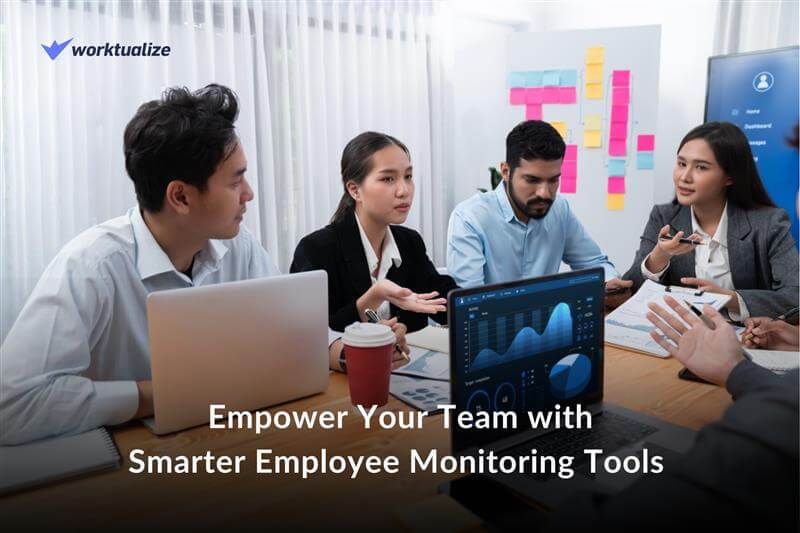We have a hybrid and remote-first world around us. And, we need to maintain employee engagement and accountability, which is becoming more challenging than ever. Teams are spread across geographies, time zones, and work styles, making it difficult for organizations to ensure that productivity, collaboration, and motivation stay consistent. This is where the employee monitoring tool landscape comes into play. It does not serve just as a surveillance mechanism, but as a strategic enabler for performance, trust, and organizational success.
With advanced analytics, AI-driven insights, and transparent tracking features, modern employee monitoring software empowers companies to optimize workflow, enhance transparency, and foster a culture of ownership. When implemented ethically and communicated clearly, these tools can become catalysts for higher engagement and stronger accountability, especially in distributed teams.
Let’s explore how employee monitoring tools drive engagement, improve accountability, and ultimately lead to a happier, more efficient workforce, and how solutions like Worktualize are redefining the balance between freedom and responsibility.
Ready to boost team productivity with clarity, transparency, and trust?
The Evolving Nature of Employee Engagement
Employee engagement used to be measured by how enthusiastic people looked in the office or how often they participated in team meetings. In the modern workplace, engagement has shifted to outcomes, consistency, and digital collaboration behavior.
With remote work, managers have lost the ability to “walk the floor” and check in on their teams. Yet, employees crave autonomy and flexibility more than ever. The challenge lies in balancing this freedom with accountability.
This is exactly where a remote employee monitoring software like Worktualize steps in — by giving both employees and employers clarity. Teams gain visibility into their own performance data, while leaders access real-time insights into productivity, time utilization, and task completion.
When engagement is driven by transparency and data, it stops being about control and starts being about continuous improvement.
What Is an Employee Monitoring Tool?
An employee monitoring tool is a digital platform designed to track and analyze employees’ work-related activities. Unlike traditional tracking systems, modern tools are built for performance workforce analytics, collaboration insights, and productivity optimization rather than surveillance.
Key features typically include:
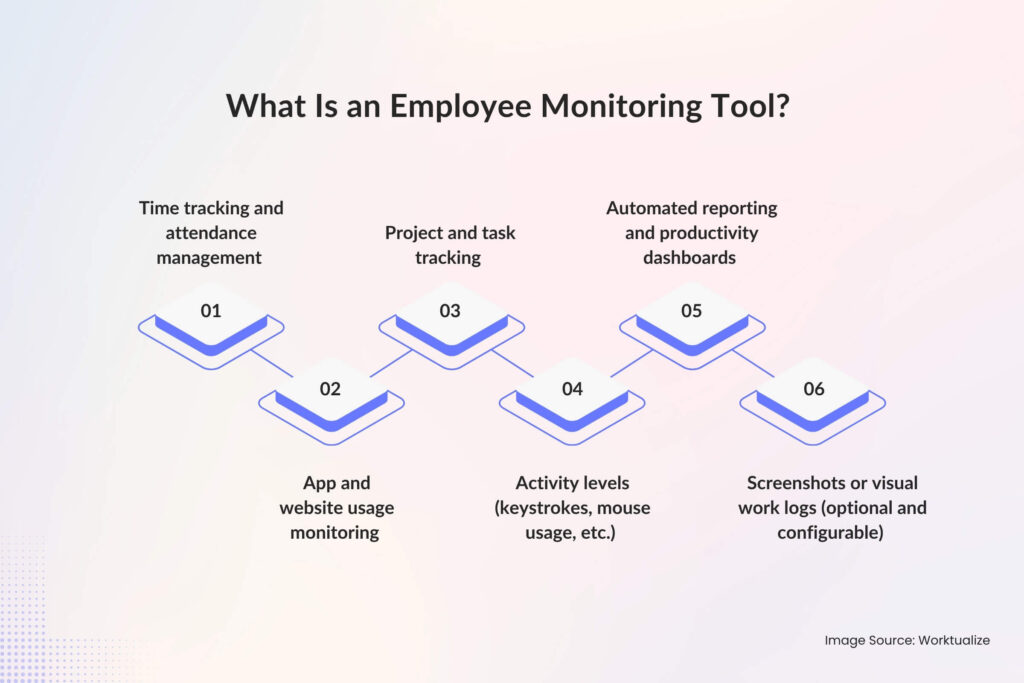
- Time tracking and attendance management
- App and website usage monitoring
- Project and task tracking
- Activity levels (keystrokes, mouse usage, etc.)
- Automated reporting and productivity dashboards
- Screenshots or visual work logs (optional and configurable)
When used ethically, employee monitoring software helps organizations not only identify performance bottlenecks but also recognize top performers, balance workloads, and align goals effectively.
Why Employee Monitoring Is Not Surveillance
Let’s address a common misconception: monitoring does not equal micromanagement.
The modern employee monitoring tool isn’t built to spy on people. Instead, it provides transparency and structure in an otherwise unstructured environment. By showing employees exactly how their time and efforts contribute to team objectives, monitoring systems actually empower individuals.
Transparency removes ambiguity. When both managers and team members have access to the same data, it fosters mutual trust. Employees can see their progress, identify inefficiencies, and take ownership of their improvement journey.
In fact, surveys indicate that over 70% of remote employees feel more confident about their performance when they have access to their productivity metrics. That’s proof that data, when shared responsibly, builds confidence, not fear.
How Employee Monitoring Tools Improve Engagement
Engagement is not just about job satisfaction; rather, it’s about purpose, motivation, and connection. A smart remote employee monitoring software enhances engagement through multiple channels:
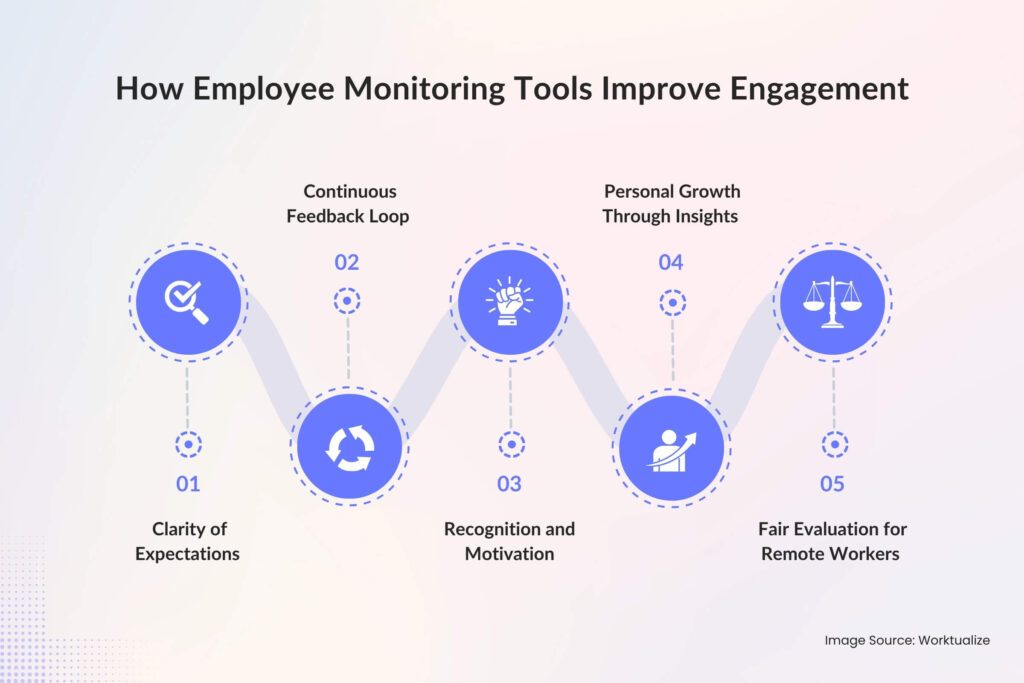
1. Clarity of Expectations
When employees know what’s being measured and why, they work with more focus. Monitoring tools clarify performance expectations by providing transparent KPIs and real-time progress metrics.
2. Continuous Feedback Loop
A good employee monitoring software feeds data into a feedback system that managers can use to coach, reward, or support their teams. Instead of annual reviews, feedback becomes immediate and data-backed.
3. Recognition and Motivation
Performance dashboards make it easy to identify consistent performers. Recognizing top contributors in weekly or monthly updates builds morale and inspires others.
4. Personal Growth Through Insights
Employees can review their productivity data, understand patterns (e.g., peak hours, distractions), and optimize their workflows. This sense of self-improvement strengthens engagement.
5. Fair Evaluation for Remote Workers
Remote workers often fear being “invisible.” With a remote employee monitoring software, performance is tracked objectively, ensuring recognition is based on data rather than proximity or visibility.
In essence, these tools shift engagement from guesswork to data-driven decision for better project management.
Transform the way your hybrid teams work — try Worktualize’s smart monitoring tools now!
Accountability: The Cornerstone of Productive Teams
Accountability ensures that every team member understands their responsibility and delivers accordingly. When accountability weakens, so does trust, leading to delayed projects, miscommunication, and burnout.
Modern employee monitoring tools strengthen accountability by making work visible, measurable, and fair.
Here’s how they do it:
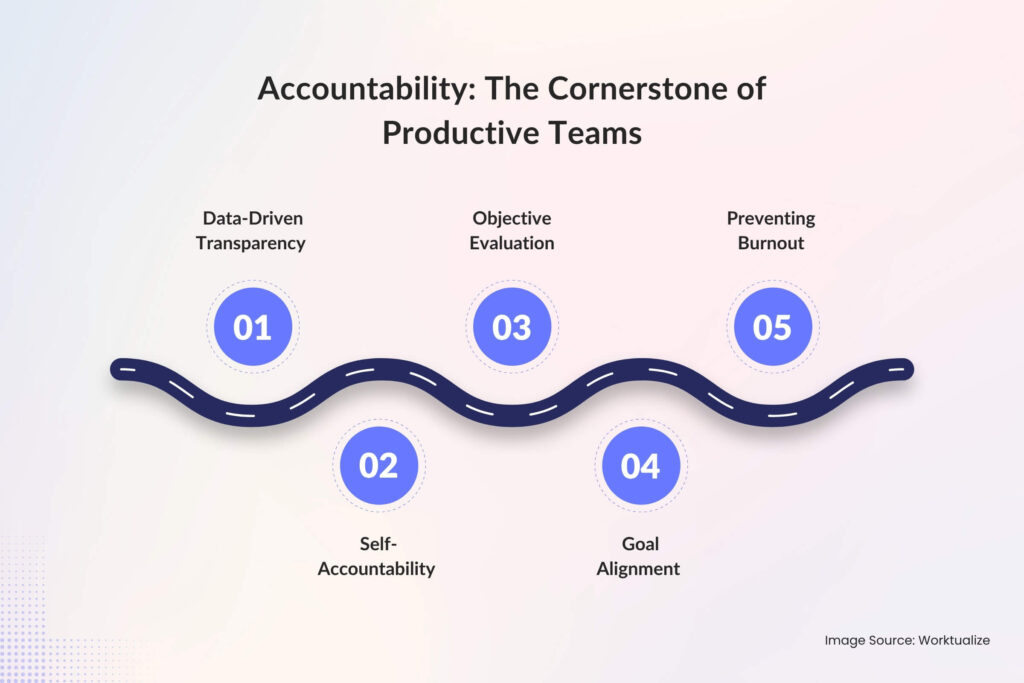
1. Data-Driven Transparency
With detailed reports from an employee monitoring tool, managers no longer rely on assumptions. The system provides evidence-based insights into work habits, time spent on projects, and overall team productivity.
2. Self-Accountability
When employees can view their own activity reports, they naturally self-correct inefficiencies. It becomes less about supervision and more about personal responsibility.
3. Objective Evaluation
Monitoring data ensures that performance reviews are based on facts, not opinions. Employees appreciate fairness, which encourages accountability across teams.
4. Goal Alignment
Through integrated dashboards, both managers and employees can track progress toward shared goals, reducing confusion and increasing ownership.
5. Preventing Burnout
Interestingly, monitoring tools don’t just track work; they also reveal overwork. When analytics show employees logging excessive hours, it prompts managers to address workload distribution and encourage healthy boundaries — an essential aspect of sustainable accountability.
Addressing Privacy Concerns
Transparency and communication are key. Before deploying an employee monitoring software, it’s vital to explain what will be monitored, why, and how.
Employees should know:
- What data is collected (e.g., activity logs, work hours, productivity stats)
- How it will be used (e.g., performance feedback, workflow improvement)
- What’s not being tracked (e.g., personal content or off-work activity)
Companies like Worktualize design tools that prioritize ethical monitoring. The goal is to empower, not invade. Features such as customizable monitoring levels, consent-based screenshots, and privacy-first analytics ensure compliance with labor and data protection laws globally.
The Role of Remote Employee Monitoring Software in the Hybrid Era
With the rise of global teams and flexible work models, remote employee monitoring software is now a cornerstone of digital workforce management.
Whether teams are working from home, co-working spaces, or multiple offices, these tools help unify performance measurement across all environments.
Key Benefits for Hybrid Teams:
- Uniform Productivity Metrics: Every team member is evaluated using the same standards, regardless of location.
- Cross-Department Visibility: Managers can see project progress and dependencies across distributed teams.
- Reduced Miscommunication: Automated updates and reports minimize status meetings and confusion.
- Increased Trust: Transparent systems reassure both managers and employees that everyone is contributing fairly.
As hybrid models mature, monitoring tools become less about control and more about creating a shared sense of purpose and performance visibility.
Best Practices for Using Employee Monitoring Tools
To maximize engagement and accountability while avoiding resistance, follow these proven practices:
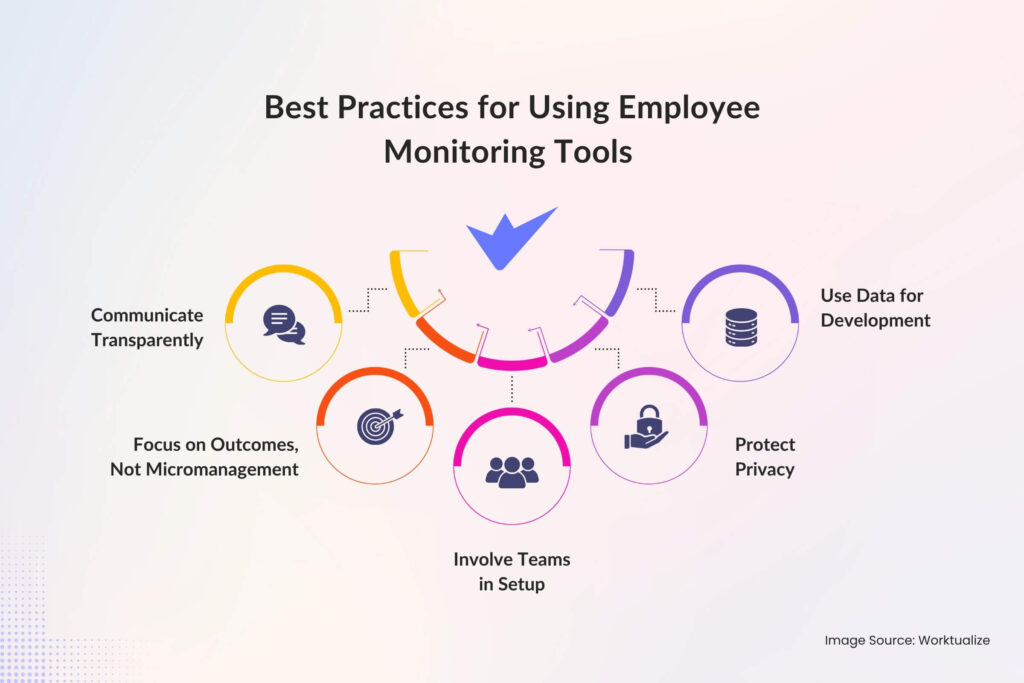
- Communicate Transparently – Clearly explain why the employee monitoring tool is being introduced and how it benefits everyone.
- Focus on Outcomes, Not Micromanagement – Use metrics to guide improvement, not to penalize employees.
- Involve Teams in Setup – Let employees have input on what’s monitored and how reports are shared.
- Protect Privacy – Ensure compliance with data protection laws and respect personal time.
- Use Data for Development – Turn analytics into coaching opportunities, not control mechanisms.
When handled ethically, monitoring becomes a collaboration enhancer, not a disruptor.
Introducing Worktualize: The Smarter Way to Monitor and Motivate
As businesses adapt to remote and hybrid work, Worktualize stands out as a next-generation employee monitoring tool designed to balance transparency with trust.
Unlike generic tracking software, Worktualize emphasizes engagement, accountability, and human-centric productivity.
Key Features of Worktualize:
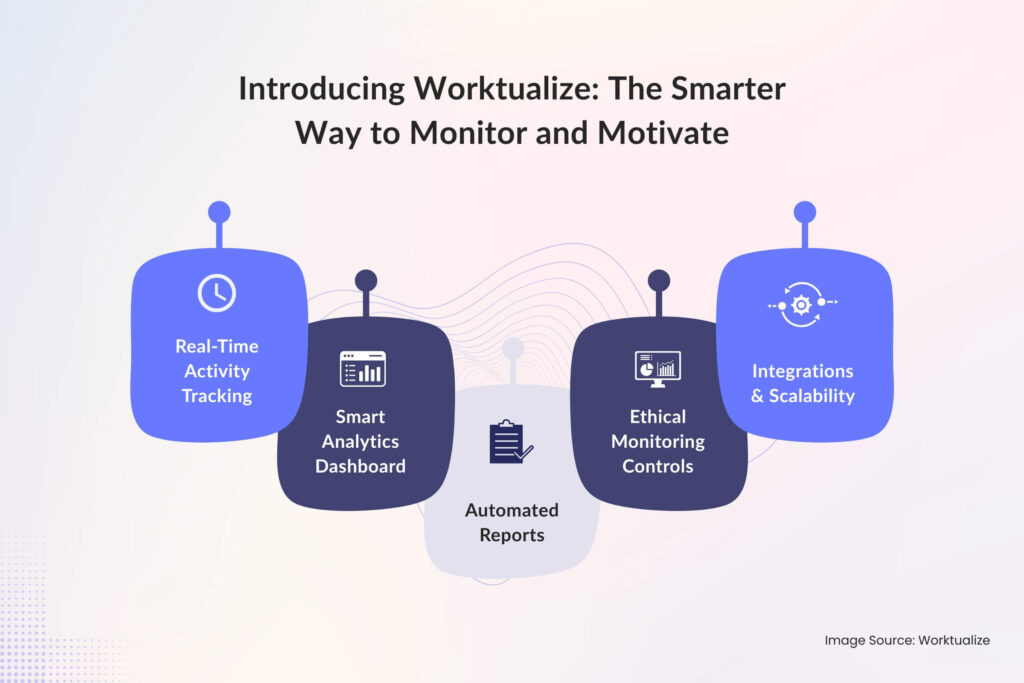
- Real-Time Activity Tracking: Monitor productivity without intruding on privacy.
- Smart Analytics Dashboard: Visualize team performance, engagement levels, and work trends.
- Automated Reports: Get daily, weekly, or custom reports tailored to your business needs.
- Ethical Monitoring Controls: Employees are informed, and sensitive data remains secure.
- Integrations & Scalability: Connect seamlessly with your project management tools and scale across departments.
Why Companies Choose Worktualize
Because it’s not just an employee monitoring software — it’s a workforce empowerment platform. Worktualize helps organizations create data-driven cultures where every team member knows their impact, every manager gains actionable insights, and engagement thrives naturally.
In other words, it helps teams work smarter, not under pressure.
The Future of Engagement and Accountability
Employee work monitoring will continue to evolve with AI and predictive analytics. Soon, tools like Worktualize will not just report what employees are doing — they’ll predict burnout risks, identify learning opportunities, and personalize engagement strategies.
By leveraging data responsibly, organizations can create psychologically safe, high-performing environments where transparency leads to empowerment, not anxiety.
Final Thoughts
A well-implemented employee monitoring tool bridges the gap between autonomy and accountability. It transforms remote work from a logistical challenge into a thriving, data-driven ecosystem where trust and transparency coexist.
When employees see monitoring as support, not surveillance, engagement flourishes. When managers use insights to coach, not control, accountability strengthens.
In the end, the right technology, like Worktualize’s remote employee monitoring software, can empower organizations to achieve the perfect balance between performance, privacy, and purpose.
If you’re ready to transform how your teams engage, perform, and stay accountable, it’s time to explore Worktualize, the future of intelligent employee monitoring.
